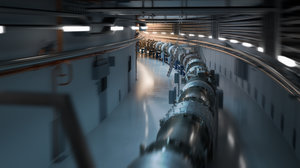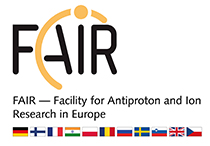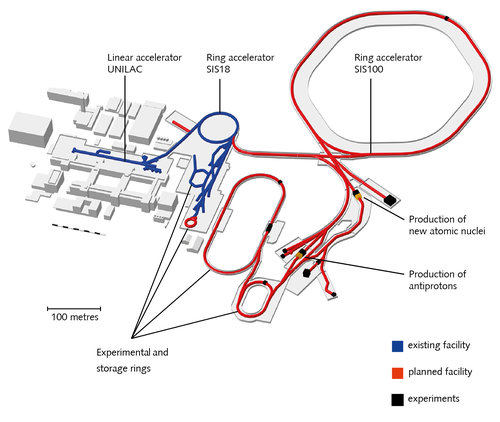The Accelerator Facility
FAIR will be one of the largest and most complex accelerator facilities in the world. The FAIR accelerator facility will have the unique ability to provide particle beams of all the chemical elements (or their ions), as well as antiprotons. The particles will be accelerated to almost the speed of light in the FAIR accelerator facility and made available for scientific experiments. FAIR will generate particle beams of a outstanding intensity and quality. The FAIR facility consists of a superconducting ring accelerator with a circumference of 1,100 meters, storage rings and experiment sites with several kilometers of beam line in total. The existing accelerator facility of the GSI Helmholtzzentrum für Schwerionenforschung will serve as the injector for the new FAIR facility.
Ring Accelerator SIS100
The SIS100 ring accelerator runs along an underground tunnel whose floor lies as deep as 17 meters under the earth’s surface. The SIS100 has a circumference of 1,100 meters and can accelerate the ions of all the natural elements in the periodic table to speeds as high as 99% of the speed of light. The magnets that keep the ions in their paths are superconducting and are cooled to -269°C by means of liquid helium. The accelerated particles are either used directly for experiments or for the production of other particles, so-called secondary particles.


Storage rings
Connected to the SIS100 ring accelerator and the Super-FRS is a complex system of storage rings and experiment stations. The newly produced particles can be captured in storage rings. Thus, these valuable and rare particles are not lost to the science teams. . On the contrary, the researchers can conduct new experiments with these particles every time they fly past. This is a clever trick, because the repeated use of a particle is indirectly equivalent to a further increase in intensity, but this increase does not require the use of the accelerator facility.
GSI — the first stage of acceleration
The existing GSI accelerators will serve as the first acceleration stage. The linear accelerator UNILAC, which is 120 meters long, accelerates particles to speeds as high as 20% of the speed of light. The SIS18 ring accelerator, which has a circumference of 216 meters, accelerates particles to speeds as high as 90% of the speed of light. The ions can then be shot from the SIS18 into the SIS100 ring accelerator.


